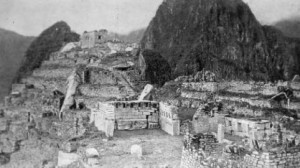Hiram Bingham III was a distinguished scholar and public servant attached to a line of the Bingham family that has lived in Salem, Connecticut, for generations. Born on November 19, 1875, in Honolulu, Hawaii, where his parents served as missionaries, Bingham resisted his family’s urgings to pursue a similar career. After completing his PhD at Harvard University, he became an adjunct professor of Latin American history at Yale University in 1907. Shortly thereafter, Bingham made one of the most famous discoveries in archeological history.
Discovering Machu Picchu

Photograph by Hiram Bingham of the Sacred Plaza at Machu Picchu, Peru – Western History/Genealogy Department, Denver Public Library
In a series of three expeditions from 1911 to 1915, Bingham discovered and excavated the ancient Inca village of Machu Picchu, which was unknown beyond a small number of indigenous people and, possibly, missionaries who had earlier traveled through the area. Often referred to as “the mountain city,” Machu Picchu is located high in the Andes Mountains of Peru and is thought to be the last refuge of the Incas—an empire that lasted for almost 500 years. This majestic landscape is dotted with granite temples and palaces and, perhaps most famously, a series of terraced farms arranged down the side of the mountain.
Bingham discovered Machu Picchu as part of the Yale Peruvian Expedition. The expedition had its roots in the expansion of US influence in Latin America during the early 20th century. American politicians saw opportunities in Latin America to expand US markets and cultivate new political alliances. The Yale Peruvian Expedition was just one of a number of scientific forays sponsored by American universities during this time in which institutions like Yale, Harvard, and Stanford competed for discoveries to boost their scholarly prestige.
From Explorer to State Politician
After his initial discovery, Bingham returned to Machu Picchu two more times (under the auspices of Yale University and the National Geographic Society) to further the excavation and cataloging of the site. His last trip ended in 1915, along with his service to Yale.
Bingham spent the remainder of his life working primarily in politics. He became lieutenant governor of Connecticut in 1922 and was elected governor in November of 1924. Before he could serve, however, the death of Connecticut Senator Frank B. Brandegee necessitated a special election, which Bingham won. In 1926, voters re-elected Bingham to serve a full six-year term.
Bingham died in Washington, DC, on June 6, 1956, at the age of 80. His primary legacy remains that of the Machu Picchu discovery. Since its excavation, the site has become one of the most popular tourist destinations in the world. In his honor, the Peruvian government named the main road to Machu Picchu the Hiram Bingham Highway.









